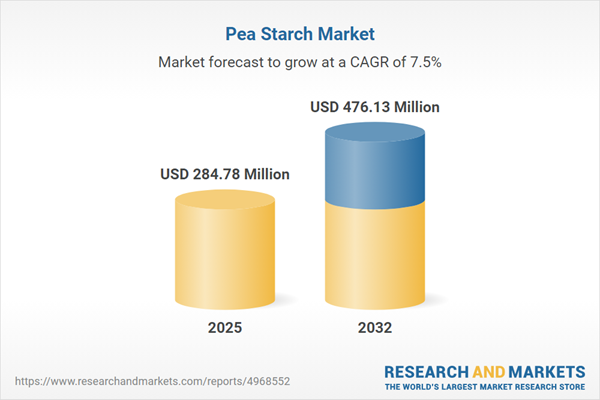Speak directly to the analyst to clarify any post sales queries you may have.
Pea starch is rapidly gaining attention among manufacturers and supply chain leaders as a vital component for improving formulations, driving sustainability, and navigating regulatory change. Amid shifting industry dynamics and consumer preferences, senior decision-makers require data-driven strategies to unlock opportunities in this evolving sector.
Pea Starch Market Snapshot
The pea starch market grew from USD 266.05 million in 2024 to USD 284.78 million in 2025. It is expected to maintain strong momentum, with a 7.54% CAGR projected to propel the market to USD 476.13 million by 2032. Robust demand is emerging across diverse industries, supported by advances in technology, clean-label momentum, and food innovation. Global adoption is fueled by applications in food, animal nutrition, packaging, and industrial processes, reflecting the sector’s adaptability to evolving needs.
Scope & Segmentation
This market intelligence offers a comprehensive breakdown of all core dimensions, delineating where growth, innovation, and operational improvements are most impactful. The main areas of focus include:
- Source: Conventional, Organic
- Product Type: Modified Pea Starch (Chemically Modified, Enzymatically Modified, Physically Modified), Native Pea Starch
- Functionality: Binding Agent, Gelling Agent, Stabilizing Agent, Texturizing Agent, Thickening Agent
- Form: Dry, Liquid
- Grade: Feed Grade, Food Grade, Industrial Grade
- Application: Animal Feed (Livestock feed, Pet food), Food Application (Bakery Products, Confectionery Products, Meat & Poultry Products, Soups & Sauces), Non-Food Application (Cosmetics, Papermaking, Pharmaceuticals, Textiles)
- Distribution Channel: Offline (Direct Sales, Distributors, Retailers), Online
- Regions: Americas (United States, Canada, Mexico, Brazil, Argentina, Chile, Colombia, Peru), Europe, Middle East & Africa (United Kingdom, Germany, France, Russia, Italy, Spain, Netherlands, Sweden, Poland, Switzerland, United Arab Emirates, Saudi Arabia, Qatar, Turkey, Israel, South Africa, Nigeria, Egypt, Kenya), Asia-Pacific (China, India, Japan, Australia, South Korea, Indonesia, Thailand, Malaysia, Singapore, Taiwan)
- Key Companies: Includes A&B Ingredients, Agridient B.V., AGT Food and Ingredients, Ingredion Incorporated, Roquette Frères S.A., PURIS, and others innovating across technology, supply, and application.
Key Takeaways for Senior Decision-Makers
- Pea starch is now central to plant-based, clean-label and allergen-sensitive product development, addressing evolving consumer and B2B requirements in global markets.
- Adoption of sustainable agricultural and water-efficient cultivation practices is reshaping sourcing strategies, supporting corporate ESG targets and operational resilience.
- Technological advances—including enzymatic treatments and novel processing methods—are enabling manufacturers to deliver tailored viscosity, gel structure, and binding properties for new applications.
- Digital transformation and data-driven logistics management are reducing risk in supply chains, enhancing traceability, yield forecasting, and supplier qualification in the face of evolving market volatility.
- Collaborative research and cross-industry partnerships drive innovation in next-generation functional starches, while strengthening compliance with emerging standards and quality mandates.
- Regional dynamics heavily influence strategic market access and product positioning, with each geography responding uniquely to regulatory frameworks and consumption trends.
Tariff Impact: 2025 U.S. Regulation
Recently implemented U.S. tariff measures are prompting manufacturers to re-examine procurement, diversify supplier networks, and recalibrate long-term supply contracts. This regulatory change is intensifying domestic capacity investments, shifting sourcing to non-traditional exporters, and compelling more agile risk management approaches throughout the value chain.
Pea Starch Market: Methodology & Data Sources
Primary and secondary research underpin this report's findings, with data drawn from stakeholder interviews, validated surveys, and critical review of industry publications. An advisory panel of sector experts ensures practical relevance and analytical integrity through scenario testing and peer validation.
Why This Report Matters to Business Leaders
- Align strategic planning with current and emerging trends in product functionality, regulatory compliance, and supply chain sustainability.
- Identify actionable opportunities by understanding granular segmentation, application-driven demand, and competitive innovation.
- Strengthen risk management and sourcing strategies in response to global geopolitical, trade, and tariff developments.
Conclusion
Industry leaders can leverage this research to navigate complexity and uncover growth levers in the pea starch sector. The actionable insights offered support innovation, value creation, and competitive advantage amid an evolving global marketplace.
Additional Product Information:
- Purchase of this report includes 1 year online access with quarterly updates.
- This report can be updated on request. Please contact our Customer Experience team using the Ask a Question widget on our website.
Table of Contents
3. Executive Summary
4. Market Overview
7. Cumulative Impact of Artificial Intelligence 2025
Companies Mentioned
The companies profiled in this Pea Starch market report include:- A&B Ingredients, Inc.
- Agridient B.V.
- AGT Food and Ingredients Inc.
- American Key Food Products LLC
- Aminola B.V.
- Axiom Foods, Inc.
- Barentz International BV
- Bioway (Xi'An) Organic Ingredients Co.,Ltd.
- Birkamidon Rohstoffhandels GmbH
- Codrico Rotterdam B.V.
- Cosucra
- Dakota Ingredients
- Dutch Ingredient Company B.V.
- Ebro Foods, S.A.
- Foodchem International Corporation
- Foodcom S.A.
- Gillco Ingredients
- Hangzhou Pekhill Foods Co., Ltd.
- Healy Group
- Ingredion Incorporated
- Jiujiang Tiantai Food Co., Ltd.
- Laybio
- Leroma GmbH
- Makendi WorldWide
- Meelunie B.V.
- Nutraonly (Xi'an) Nutritions Inc.
- NutriPea LP
- P&H Milling, Inc.
- Prinova Group LLC
- PURIS
- Roquette Frères S.A.
- Royal Ingredients Group B.V.
- Sanstar Bio - Polymers Ltd.
- Shandong Jianyuan Group
- Stauber Performance Ingredients, Inc.
- STDM Food and Beverages Private Limited
- The BakeRite Company
- The Scoular Company
- Vestkorn by Koninklijke DSM N.V.
- Yantai Shuangta Food Co., Ltd.
Table Information
| Report Attribute | Details |
|---|---|
| No. of Pages | 198 |
| Published | November 2025 |
| Forecast Period | 2025 - 2032 |
| Estimated Market Value ( USD | $ 284.78 Million |
| Forecasted Market Value ( USD | $ 476.13 Million |
| Compound Annual Growth Rate | 7.5% |
| Regions Covered | Global |
| No. of Companies Mentioned | 41 |









